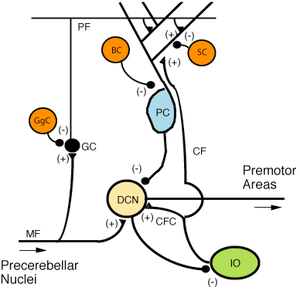Stellate cell
| Stellate cell | |
|---|---|
 Microcircuitry of the cerebellum. Excitatory synapses are denoted by (+) and inhibitory synapses by (-). MF: Mossy fiber. DCN: Deep cerebellar nuclei. IO: Inferior olive. CF: Climbing fiber. GC: Granule cell. PF: Parallel fiber. PC: Purkinje cell. GgC: Golgi cell. SC: Stellate cell. BC: Basket cell. | |
| Identifiers | |
| NeuroLex ID | Stellate Cell |
| TH | H1.00.01.0.00047 |
Stellate cells are any cells that have a star-like shape formed by dendritic processes radiating from the cell body. They appear in a number of different parts of the body.
In neuroscience, stellate cells are neurons. The three most common stellate cells are the inhibitory interneurons found within the molecular layer of the cerebellum, excitatory spiny stellate cells and inhibitory aspiny stellate interneurons. Cerebellar stellate cells synapse onto the dendritic arbors of Purkinje cells. Cortical spiny stellate cells are found in layer IVC of the V1 region in the visual cortex. They receive excitatory synaptic fibres from the thalamus and process feed forward excitation to 2/3 layer of V1 visual cortex to pyramidal cells. Cortical spiny stellate cells have a 'regular' firing pattern. Stellate cells are chromophobes.
In the skeleton, the osteocyte is a stellate cell, embedded within the bone matrix itself. These cells have multiple interconnecting processes that form an extensive interconnected network throughout the skeleton.[1][2]
Other stellate cells in the body include the Hepatic stellate cell, Pancreatic stellate cell, and the podocyte in the kidney.